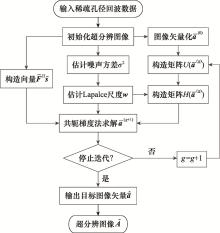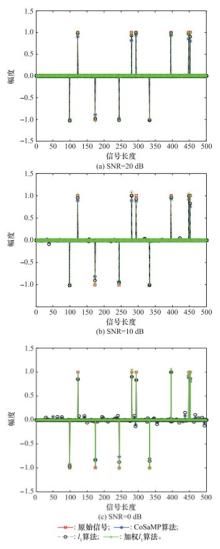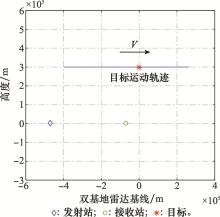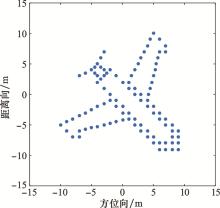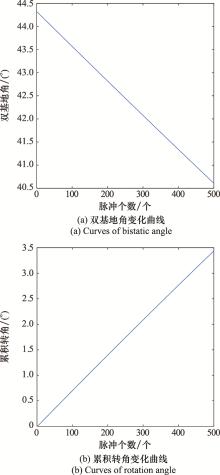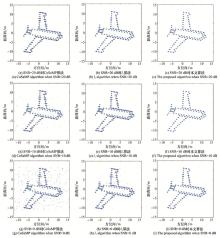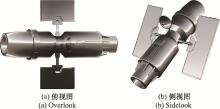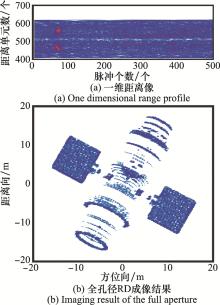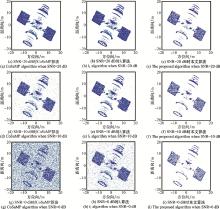Systems Engineering and Electronics ›› 2021, Vol. 43 ›› Issue (4): 944-953.doi: 10.12305/j.issn.1001-506X.2021.04.11
• Sensors and Signal Processing • Previous Articles Next Articles
Bi-ISAR imaging based on weighted l1 norm optimization algorithm
Dongfang XUE( ), Xiaoxiu ZHU*(
), Xiaoxiu ZHU*( ), Wenhua HU(
), Wenhua HU( ), Baofeng GUO(
), Baofeng GUO( ), Huiyan ZENG(
), Huiyan ZENG( )
)
- Shijiazhuang Campus of the Army Engineering University, Shijiazhuang 050003, China
-
Received:2020-06-05Online:2021-03-25Published:2021-03-31 -
Contact:Xiaoxiu ZHU E-mail:dongfang_25@163.com;zhuxiaoxiu13@163.com;hwhsaq@sina.com;15132497492@126.com;15200011917@126.com
CLC Number:
Cite this article
Dongfang XUE, Xiaoxiu ZHU, Wenhua HU, Baofeng GUO, Huiyan ZENG. Bi-ISAR imaging based on weighted l1 norm optimization algorithm[J]. Systems Engineering and Electronics, 2021, 43(4): 944-953.
share this article
Table 3
Comparisons of imaging evaluation indicators under different SNRs"
| 算法 | 图像衡量标准 | SNR/dB | ||
| 20 | 10 | 0 | ||
| CoSaMP算法 | C | 30.614 1 | 27.174 4 | 23.491 7 |
| TBR | 34.942 1 | 32.697 9 | 20.038 6 | |
| RMSE | 10.974 4 | 12.216 8 | 13.724 7 | |
| l1范数算法 | C | 36.783 5 | 29.432 5 | 26.342 6 |
| TBR | 67.423 5 | 47.388 1 | 28.372 5 | |
| RMSE | 10.686 3 | 11.454 3 | 12.054 3 | |
| 本文算法 | C | 44.379 7 | 42.366 7 | 41.094 8 |
| TBR | 95.238 1 | 92.434 7 | 80.656 6 | |
| RMSE | 10.324 6 | 10.551 4 | 10.845 4 | |
| 1 |
KANG B S , BAE J H , KANG M S , et al. Bistatic-ISAR cross-range scaling[J]. IEEE Trans.on Aerospace and Electronic Systems, 2017, 53 (4): 1962- 1673.
doi: 10.1109/TAES.2017.2677798 |
| 2 |
KANG M , LEE S , KIM K , et al. Bistatic ISAR imaging and scaling of highly maneuvering target with complex motion via compressive sensing[J]. IEEE Trans.on Aerospace and Electronic Systems, 2018, 54 (6): 2809- 2826.
doi: 10.1109/TAES.2018.2830598 |
| 3 | ZHANG S , SUN S , ZHANG W , et al. High-resolution bistatic ISAR image formation for high-speed and complex-motion targets[J]. IEEE Journal of Selected Topics in Applied Earth Observations and Remote Sensing, 2017, 8 (7): 3520- 3531. |
| 4 |
SHI L , ZHU X , SHANG C , et al. High-resolution bistatic ISAR imaging of a space target with sparse aperture[J]. Electronics, 2019, 8 (8): 874.
doi: 10.3390/electronics8080874 |
| 5 |
SHI L , GUO B F , MA J T , et al. A novel channel calibration method for bistatic ISAR imaging system[J]. Applied Science, 2018, 8 (11): 2160.
doi: 10.3390/app8112160 |
| 6 | ZHU X , SHI L , GUO B , et al. Bi-ISAR sparse imaging algorithm with complex Gaussian scale mixture prior[J]. IET Radar, Sonar & Navigation, 2019, 13 (12): 2202- 2211. |
| 7 | HU W, ZHU X, GUO B, et al. A bistatic ISAR sparse aperture high resolution Imaging algorithm based on ROMP algorithm[C]// Proc. of the IEEE 3rd Information Technology, Networking, Electronic and Automation Control Conference, 2019: 490-494. |
| 8 |
ZHANG S , LIU Y , LI X . Bayesian bistatic ISAR imaging for targets with complex motion under low SNR condition[J]. IEEE Trans.on Image Processing, 2018, 27 (5): 2447- 2460.
doi: 10.1109/TIP.2018.2803300 |
| 9 |
ZHANG S , LIU Y , LI X . Fast sparse aperture ISAR autofocusing and imaging via ADMM based sparse Bayesian learning[J]. IEEE Trans.on Image Processing, 2020, 29, 3213- 3226.
doi: 10.1109/TIP.2019.2957939 |
| 10 |
XIANG L , LI S , YANG J , et al. A fast decoupled ISAR high-resolution imaging method using structural sparse information under low SNR[J]. Journal of Systems Engineering and Electronics, 2019, 30 (3): 492- 503.
doi: 10.21629/JSEE.2019.03.07 |
| 11 |
ZHANG S , LIU Y , LI X , et al. Joint sparse aperture ISAR autofocusing and scaling via modified Newton method-based variational Bayesian inference[J]. IEEE Trans.on Geoscience and Remote Sensing, 2019, 57 (7): 4857- 4869.
doi: 10.1109/TGRS.2019.2893505 |
| 12 |
QIU W , ZHOU J , FU Q . Jointly using low-rank and sparsity priors for sparse inverse synthetic aperture radar imaging[J]. IEEE Trans.on Image Processing, 2020, 29, 100- 115.
doi: 10.1109/TIP.2019.2927458 |
| 13 | HAMAD A. Compressive sensing based algorithm for rotational motion estimation and compensation for ISAR imaging[C]//Proc. of the International Radar Conference, 2019: 1-6. |
| 14 |
ZHANG Y , XING M . Joint method of ISAR imaging and scaling for maneuvering targets via compressive sensing[J]. IEEE Sensors Journal, 2019, 19 (17): 7300- 7307.
doi: 10.1109/JSEN.2019.2897383 |
| 15 |
DONOHO D L . Compressed sensing[J]. IEEE Trans.on Information Theory, 2006, 52 (4): 1289- 1306.
doi: 10.1109/TIT.2006.871582 |
| 16 |
GIUSTI E , CATALDOA D , BACCI A , et al. ISAR image re-solution enhancement: compressive sensing versus state-of-the-art super-resolution techniques[J]. IEEE Trans.on Aerospace and Electronic Systems, 2018, 54 (4): 1983- 1997.
doi: 10.1109/TAES.2018.2807283 |
| 17 | 徐刚, 包敏, 李亚超, 等. 基于贝叶斯估计的高精度ISAR成像[J]. 系统工程与电子技术, 2011, 33 (11): 2382- 2388. |
| XU G , BAO M , LI Y C , et al. High precision ISAR imaging via Bayesian statistic[J]. Systems Engineering and Electronics, 2011, 33 (11): 2382- 2388. | |
| 18 |
ZHANG L , QIAO Z J , XING M D , et al. High-resolution ISAR imaging by exploiting sparse apertures[J]. IEEE Trans.on Antennas and Propagation, 2012, 60 (2): 997- 1008.
doi: 10.1109/TAP.2011.2173130 |
| 19 |
ZHANG L , WANG H , QIAO Z J . Resolution enhancement for ISAR imaging via improved statistical compressive sensing[J]. EURASIP Journal on Advances in Signal Processing, 2016, 80
doi: 10.1186/s13634-016-0379-2 |
| 20 | 朱晓秀, 胡文华, 马俊涛, 等. 双基地角时变下的ISAR稀疏孔径自聚焦成像[J]. 航空学报, 2018, 39 (8): 322059- 322059. |
| ZHU X X , HU W H , MA J T , et al. ISAR autofocusing imaging with sparse apertures and time-varying bistatic angle[J]. Acta Aeronautica et Astronautica Sinica, 2018, 39 (8): 322059- 322059. | |
| 21 | 郭宝锋, 尚朝轩, 王俊岭, 等. 双基地角时变下的逆合成孔径雷达越分辨单元徙动校正算法[J]. 物理学报, 2014, 63 (23): 408- 419. |
| GUO B F , SHANG C X , WANG J L , et al. Correction of migration through resolution cell in bistatic inverse synthetic aperture radar in the presence of time-varying bistatic angle[J]. Acta Physica Sinica, 2014, 63 (23): 408- 419. | |
| 22 |
BABACAN S , MOLINA R , KATSAGGELOS A . Bayesian compressive sensing using Laplace priors[J]. IEEE Trans.on Imaging Processing, 2010, 19 (1): 53- 63.
doi: 10.1109/TIP.2009.2032894 |
| 23 | CHEN V C, ROSIERS A, LIPPS R. Bi-static ISAR range-Doppler imaging and resolution analysis[C]//Proc. of the IEEE Radar Conference, 2009: 1-5. |
| 24 | WU Q. A nonlinear conjugate gradient method without line search and its global convergence[C]//Proc. of the International Conference on Computational and Information Sciences, 2011: 1148-1152. |
| 25 |
CETIN M , KARL W C . Feature-enhanced synthetic aperture radar image formation based on nonquadratic regularization[J]. IEEE Trans.on Imaging Processing, 2001, 10 (4): 623- 631.
doi: 10.1109/83.913596 |
| 26 |
NEEDELL D , TROPP J A . CoSaMP: iterative signal recovery from incomplete and inaccurate samples[J]. Applied and Computational Harmonic Analysis, 2009, 26 (3): 301- 321.
doi: 10.1016/j.acha.2008.07.002 |
| 27 |
WEINMANN F . Ray tracing with PO/PTD for RCS modeling of large complex objects[J]. IEEE Trans.on Antennas and Propagation, 2006, 54 (6): 1797- 1806.
doi: 10.1109/TAP.2006.875910 |
| [1] | Feng RUAN, Liang GUO, Yachao LI, Ran XU. Phased array radar forward-looking imaging based on correlated imaging [J]. Systems Engineering and Electronics, 2021, 43(9): 2457-2462. |
| [2] | Yunfei MA, Xisheng JIA, Huajun BAI, Chiming GUO, Shuangchuan WANG. Fault diagnosis of compressed vibration signal based on 1-dimensional CNN with optimized parameters [J]. Systems Engineering and Electronics, 2020, 42(9): 1911-1919. |
| [3] | Chu XU, Dongqiang ZHU, Ling WANG, Jie WANG. ISAR imaging using null space l1 norm minimization [J]. Systems Engineering and Electronics, 2020, 42(2): 315-321. |
| [4] | Yi DU, Kefei LIAO, YANG Shan OU, Yijun CHEN. Two-dimensional resource adaptive scheduling algorithm for ISAR imaging system [J]. Systems Engineering and Electronics, 2020, 42(2): 339-345. |
| [5] | Jingjing SI, Yanan HAN, Lei ZHANG, Yinbo CHENG. 1-Bit compressive sensing based on generalized pattern-coupled sparse Bayesian learning [J]. Systems Engineering and Electronics, 2020, 42(12): 2700-2707. |
| [6] | WU Qing, ZANG Boyan, QI Zongxian, ZHANG Yu. Multi-kernal sparse least square support vector machine using compressive sensing [J]. Systems Engineering and Electronics, 2019, 41(9): 1930-1936. |
| [7] | ZHANG Yongshun, ZHU Weigang, JIA Xin, WANG Manxi. NBI detection and parameter estimation in DSSS communications based on BSBL [J]. Systems Engineering and Electronics, 2019, 41(4): 889-897. |
| [8] | YAO Di, ZHANG Xin, WU Xiaochuan, YANG Qiang, DONG Yingning, DENG Weibo. Single snapshot DOA estimation algorithm based on iteration continuous basis pursuit for HFSWR [J]. Systems Engineering and Electronics, 2017, 39(7): 1480-1485. |
| [9] | XIE Zhonghua, MA Lihong. Approximate message passing based on low-rank constraint and side information for CS recovery [J]. Systems Engineering and Electronics, 2017, 39(5): 968-976. |
| [10] | ZHAO Kexiang, BI Hui, ZHANG Bingchen. SAR tomography method based on fast iterative shrinkage-thresholding [J]. Systems Engineering and Electronics, 2017, 39(5): 1019-1023. |
| [11] | ZHAO Chunlei, WANG Yaliang, MAO Xingpeng, YU Changjun. Compressive sensing based two-dimensional DOA estimation for high frequency surface wave radar [J]. Systems Engineering and Electronics, 2017, 39(4): 733-741. |
| [12] | DUAN Hua-jun, ZHU Dai-yin, LI Yong, WU Di. Recovery and imaging method for missing data of the strip-map SAR based on compressive sensing [J]. Systems Engineering and Electronics, 2016, 38(5): 1025-. |
| [13] | LIU Kai, FANG Xiao-jun, HUANG Qing-hua. Device-free localization based on RTI bi-reconstruction algorithm with wireless sensor networks [J]. Systems Engineering and Electronics, 2016, 38(1): 31-36. |
| [14] | BI Hui, JIANG Cheng-long, WANG Wan-ying, ZHANG Bing-chen, HONG Wen. Track distribution optimization for tomographic synthetic aperture radar imaging [J]. Systems Engineering and Electronics, 2015, 37(8): 1787-1792. |
| [15] | PENG Zhen-ni, BEN De, ZHANG Gong. Measurement matrix optimization for CS-MIMO radar based on chaotic random filter [J]. Systems Engineering and Electronics, 2015, 37(3): 532-536. |
| Viewed | ||||||
|
Full text |
|
|||||
|
Abstract |
|
|||||
